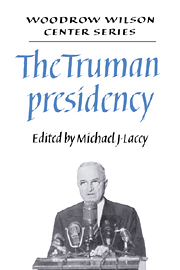Book contents
- Frontmatter
- Contents
- Acknowledgments
- Introduction and summary: The Truman era in retrospect
- 1 The mind and character of Harry S. Truman
- Part I Domestic politics and issues
- Part II Foreign policy and national defense
- 7 The national security state reconsidered: Truman and economic containment, 1945–1950
- 8 The insecurities of victory: the United States and the perception of the Soviet threat after World War II
- 9 Alliance and autonomy: European identity and U.S. foreign policy objectives in the Truman years
- 10 U.S. policy in the Near East: the triumphs and tribulations of the Truman administration
- 11 Toward a post-colonial order: Truman administration policies toward South and Southeast Asia
- 12 Occupied Japan and the cold war in Asia
- 13 The Truman administration and the Korean War
- About the authors
- Index
11 - Toward a post-colonial order: Truman administration policies toward South and Southeast Asia
Published online by Cambridge University Press: 06 October 2009
- Frontmatter
- Contents
- Acknowledgments
- Introduction and summary: The Truman era in retrospect
- 1 The mind and character of Harry S. Truman
- Part I Domestic politics and issues
- Part II Foreign policy and national defense
- 7 The national security state reconsidered: Truman and economic containment, 1945–1950
- 8 The insecurities of victory: the United States and the perception of the Soviet threat after World War II
- 9 Alliance and autonomy: European identity and U.S. foreign policy objectives in the Truman years
- 10 U.S. policy in the Near East: the triumphs and tribulations of the Truman administration
- 11 Toward a post-colonial order: Truman administration policies toward South and Southeast Asia
- 12 Occupied Japan and the cold war in Asia
- 13 The Truman administration and the Korean War
- About the authors
- Index
Summary
When Harry S. Truman suddenly entered the White House in April 1945, he faced a staggering array of problems, many of which demanded immediate attention. Certainly the future of colonial rule in South Asia and Southeast Asia did not rank very high among them. Indeed, the administration of Franklin D. Roosevelt had already agreed not to challenge the reassertion of European colonial authority in Southeast Asia and not to pressure the British on the sensitive subject of Indian independence. The untested chief executive from Independence, Missouri, had no reason to question those decisions. Nor did he have cause to question the conventional wisdom that both areas were peripheral to core U.S. interests. To be sure, during World War II the United States evinced a growing interest in the colonial territories of southern Asia; not only did those regions possess a wealth of valuable natural resources—as the events leading up to Pearl Harbor amply attest—but American strategic planners called for an enhanced U.S. military presence in the postwar Pacific. Still, as the new president prepared for the daunting tasks ahead of him, most knowledgeable observers inside and outside the government anticipated that the U.S. stake in colonial Asia would remain circumscribed indefinitely.
They could not have been more mistaken. For Truman's presidency dramatically—and probably irrevocably—transformed America's approach to the world.
- Type
- Chapter
- Information
- The Truman Presidency , pp. 339 - 365Publisher: Cambridge University PressPrint publication year: 1989
- 2
- Cited by



